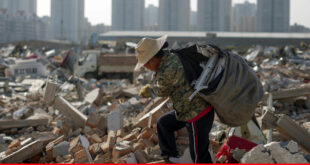Considering dollar 2 a day be the minimum daily wage, then a majority of the population of Pakistan is unfortunately living below the poverty line as these daily earning amount is not enough to meet the expenses of a family and not even fulfilling the need of a individual of this country. The poverty line is the distinction which separates those in the country who are poor from those who are not. During the unveiling of the Pakistan Economic Survey for 2013-2014, the Finance Minister, Mr. Ishaq Dar stated that in order to combat the rising levels of poverty in the country, there is a dire need to improve the economic conditions of the country and to achieve greater levels of economic growth but when and how this problem will be overcome for the suffering of the large poor population of Pakistan is a million dollar question.
In Pakistan, poverty is measured by the Ministry of Planning, Development and Reform on a consumption based approach, data for which is used from the Household Integrated Economic Survey. According to information from this survey, the poverty line in Pakistan is consumption based and calorie based absolute poverty. This is estimated by converting the household consumption level to its adult equivalent based on the nutritional requirements of 2,350 calories per day per person. The survey shows that poverty had in fact declined from 34.4 percent in 2000-2001 to 22.3 percent in 2005-2006. By the year 2010-2011, poverty had actually appeared to have improved. Based on the consumption based method, poverty stood at 12.4 percent during the mentioned period, with 15.1 percent experienced in rural areas and 7.1 percent in urban areas.
The position of poverty in Pakistan is in comparison to Bangladesh and India considered being better off, however, in comparison to countries like China, Sri Lanka and the Philippines, Pakistan is not doing that much better. The percentages of people living below the $2 poverty line in these countries stands at 29.79 percent for China, 76.54 percent for Bangladesh, 68.72 percent for India, 29.13 percent for Sri Lanka, 41.53 percent for Philippines and 57.25 percent for Nepal.
Back in the year 2000, Pakistan had adopted what is known as the Millennium Declaration, committing to do every possible thing it could to free those segments of society which were the most vulnerable and were suffering from the extreme conditions of poverty.
The Government of Pakistan is very well aware of the fact that the initial step it must take is to eradicate poverty and hunger in order to meet the first goal of the Declaration. It is also a step, which would help propel the nation in the direction towards becoming a progressive society. Under the Millennium Declaration Goal-1, by 2015, Pakistan should have halved the proportion of the number people living below the poverty line. Along with this goal, associated aims include providing employment and work for all along with the reducing the proportion of people suffering from hunger by half as well.
The Economic Survey of Pakistan defines poverty as ‘a state or condition in which a person or community lacks the financial resources and essentials to enjoy a minimum standard of life and well being that is considered acceptable in society.’ Poverty does not simply mean lacking the financial resources but it also takes into consideration a deprived well being and the inability to acquire goods and services, which are a necessity for the survival of an individual.
The government is certainly committed to improve the livelihood of the population of the country and to eradicate the extreme forms of poverty, which a large portion of the population is facing currently. There are a number of social safety net programs, which have been enforced by the government to create opportunities to enable the poor to take advantage and to escape poverty. One such program is the Benazir Income Support Program. This program has successfully managed to continue while having disbursements valuing at Rs48.18 billion till March 2014 while the number of beneficiaries have increased to Rs5.25 million.
The Pakistan Poverty Alleviation Fund is yet another initiative, which is working towards eradicating poverty in Pakistan. It is contributing large sums of funding and providing various kinds of interventions to reduce hunger and poverty which is so commonly found in the country. Furthermore, the organization is also working towards enhancing gender equality, empowering women, improving maternal health and child mortality along with increase participation by various communities. Work done by the Pakistan Poverty Alleviation Fund (PPAF) has been praised, particularly those projects undertaken by them in terms of water, infrastructure, micro-credit, education, drought mitigation and emergency responses thus showing the amount of work being conducted by them. Total disbursement through PPAF during the period of July-December 2013-14 has been Rs8.414 billion.
With the passing of the 7th National Finance Commission Award, large sums of funds are offered from the federal to the provincial governments which will provide the provinces more space and ability to play their part in reducing the disparities, which are present in the respective provinces. The passing of this award has now made it possible for the provinces to decide, plan and implement social sector projects on their own while the federal government would only be responsible for allocating chunks of the budget towards development in areas such as energy, infrastructure, improvement of the social sector and such developmental measures.
The government is also working towards keeping the inflation rate stable at a single digit by keeping a tight monetary policy, careful expenditure and its proper management, supply chain management and the control and monitoring of prices and supply of essential items. This is being done by including the provincial governments on the board in order to bring some relief for the masses.
According to the Economic Survey, it was revealed that efforts have to and will be made in order to improve the governance in the country along with the economic conditions; social protection policies would be devised and institutions, which are working for the benefits of the poor would be strengthened further. Strategies aimed at reducing poverty would be implemented in a more efficient manner and HRD indicators would also be improved by allocating a good amount under various schemes which aim to directly work towards providing those less fortunate with the resources they are in need of.
 PAGE Blog Business Weekly Magazine
PAGE Blog Business Weekly Magazine

